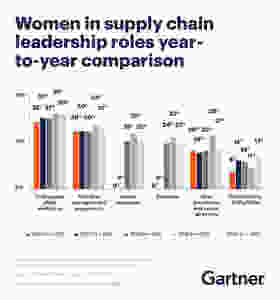While supply chain organizations deal with the impacts of the coronavirus pandemic, they still pursue gender equality goals. According to Gartner, Inc.’s 2020 Women in Supply Chain Survey among 177 supply chain professionals, 17% of chief supply chain officers (CSCOs) are now women – a 6% increase compared to 2019 and the highest rate since the first edition of the survey in 2016.
“The increase in women executive leaders over the past year is a positive sign, however the survey showed that women don’t consistently make it through the pipeline,” said Dana Stiffler, vice president analyst with the Gartner Supply Chain Practice. “Lack of progress is not something the industry can afford at the moment. Supply chain’s role in the COVID-19 pandemic and subsequent recovery is crucial, with lives and livelihoods at stake. This is a pivotal time for many women in mid-
level and senior management positions.”
Compared to 2019, there are proportionally fewer women at the vice president and director levels (see Figure 1). In 2020, 63% of respondents do have active goals, objectives or initiatives to recruit women and build pipelines, but Ms. Stiffler said it takes years for this activity to strengthen pipelines. This dynamic also contributes to representation of women in the total supply chain workforce remaining unchanged at 39% year over year.
Consumer Goods & Retail Organizations Lead the Way
At 25%, consumer goods and retail supply chain organizations’ representation of women at vice president level is nearly twice that of industrial organizations (13%). One reason for this development is that 55% of industrial organizations prefer a science, technology, engineering or math (STEM) degree for senior hires, compared to 39% of consumer organizations. As women are less likely to have a STEM background than men, they are also less likely to be hired for senior supply chain roles in industrial organizations.
“Another notable difference between industrial and consumer/retail supply chain organizations is goal setting. Consumer and retail organizations were more than twice as likely to have formal targets and specific goals in management scorecards for gender diversity,” Ms. Stiffler added.
Pipeline Planning is Key
Until recently, gender-focused inclusion and diversity initiatives focused mostly on employee resource groups and women’s leadership development programs. While organizations still value those initiatives, they have found that improved pipeline planning and management is a key factor for attracting and retaining diverse talent in leadership positions.
“Not a single respondent cited employee resource groups as a top action for progressing women to senior leadership roles in supply chain. Leadership development programs or improved work-life balance also didn’t make the list. However, 21% claim that integrated pipeline planning is their best approach. This reinforces what we have found over the years: The right place to focus for diverse senior leadership is the pipeline and the decisions that support it,” Ms. Stiffler concluded.
#women #supplychain

